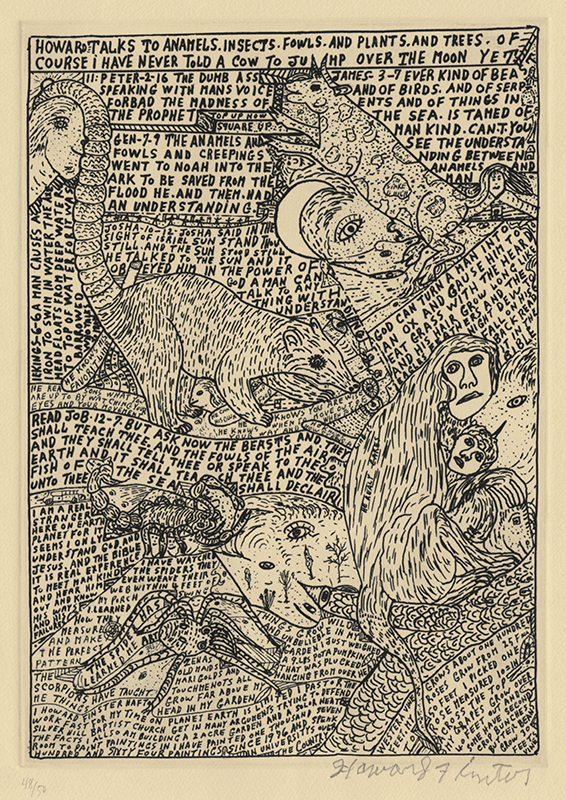Howard Talks to Animals is an etching after a drawing created about 1982 by American Outsider artist, Howard Finster. This is from the 1998 portfolio Folk Image by Howard Finster, Man of Vision. It was printed by Michelle Red Elk and Werner Kennebeck on Arches Buff wove paper in an edition of 50, this being numbered 48/50. This impression is pencil signed by Finster and the platemark measures 14-1/8 x 10-1/4 inches.
Sometime around 1982, Howard Finster created a series of drawings that would later be titled Self Portrait, Howard Talks to Animals, Tribute to Silverhill Baptist Church, and My Castle. In 1998, these were reproduced as etchings in a loose leaf portfolio entitled Folk Image / by Howard Finster, Man of Vision. The portfolio was published by Finster and Cincinnati artist, collector, and Outsider Art promoter Andrew Van Sickle. The etchings were printed by Michelle Red Elk and Werner Kennebeck at Mark Patsfall Graphics in Cincinnati, Ohio in a series of fifty impressions, with ten artist’s proofs, two printer’s proofs, two shop proofs, and one BAT. Finster signed the prints in the lower right and the edition numbers, written in a more steady hand, were probably added by the publisher.
Howard Finster, painter, sculptor, Outsider artist and
minister, was born in Valley Head, Alabama, on December 2, 1916. One of
thirteen children born to Samuel and Lula Finster, Howard began experiencing
visions sent to him in dreams at the age of three. He decided that these
visions came from God and he continued to receive them through primary and
secondary school. On the advice of his sixth grade teacher, Finster stayed
after class for a revival. Inspired, he soon decided to be baptized and dropped
out of school at age of thirteen years old with the intent to spread the word
of his visions. At the age of sixteen, he began preaching at local churches and
publishing sermons and poetry in local newspapers, and by the late 1930s he
established his own radio program.
Beginning in 1940, Finster ministered throughout Georgia for three decades. He
labored as a brick layer, carpenter, plumber, and bicycle and small-engine
repairman to support his wife Pauline and their five children. Throughout this
time Finster would translate onto paper and other surfaces what he called “painted
sermons,” using pictographic symbols he claimed were signs from God delivered
by the Holy Ghost. He referred to this written symbology as the “Unknown
Language,” and it would appear in his artwork throughout his career. After
moving to Trion, Georgia, he began to build an outdoor museum on his property,
with the intent of recreating in miniature one of everything invented by
humankind. Running out of space, he moved his family to Pennville in 1961 and
began building the Plant Farm Museum, later to be called Paradise Gardens. Four
years later, he retired from preaching to devote his time to his art garden.
Finster’s reputation as an Outsider artist grew exponentially once the Plant
Farm Museum was established, and he was featured in Esquire magazine and interviewed on local news stations. In 1976, Finster
began to pursue art in the formal sense of the word, after experiencing a
vision instructing him to “paint sacred art.” He began painting religious
motifs as well as pop culture and historic icons, political figures, and UFOs,
using paper, cardboard, wood planks, metal, and structures on the property.
These compositions often included written words and his Unknown Language
symbology. Finster claimed that God told him to create 5,000 images which led
him to number every painting he created. He accomplished that number by 1985
but continued to create and number his works; at the end of his life the number
neared 47,000.
In 1976, Finster participated in his first exhibition and, in 1977, he painted
four works for the Library of Congress. The band, The Talking Heads, commission
Finster to create an album cover which was selected by Rolling Stone magazine as Album
Cover of the Year. With the approach of the Summer Olympic Games in Atlanta
in 1996, Finster was commissioned to produce two decorated human-sized
Coca-Cola bottles. In 1998, he was approached by Mark Patsfall of Mark Patsfall
Graphics about publishing a suite of drawings, created by Finster in 1982 and
titled Finster's Folk Image, as etchings. The result was a small edition,
loose-leaf portfolio of four etching after his drawings titled Folk
Image, approved and signed by Finster.
Howard Finster's art garden, individual works, and his numerous collaborations catapulted him to fame and he was recognized as one of the leading Outsider artists in the world. His work is included in international collections and museums. Finster died in Georgia on 22 October 2001. After his death, Paradise Gardens fell into disrepair but is currently under restoration.



